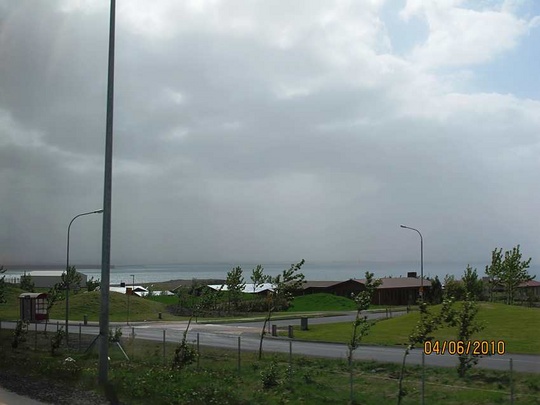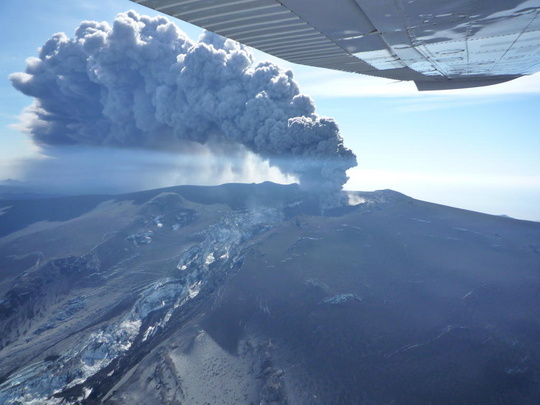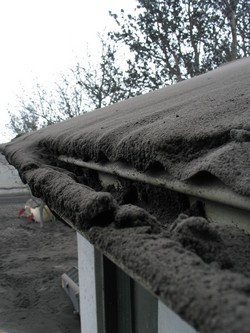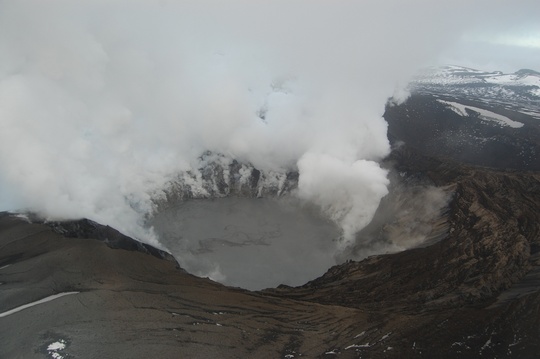"feet on the ground but head in the clouds"
Image: Icelandic Met Office : Eyjafjallajökull eruption: This closed -Up Is taken at 8:30 p.m. Monday evening 19 April 2010 from a small airplane flying at 6000 ft (1.8 km).
Chernobyl, the cloud (having probably no visa, could not cross the border) then we could see that the East of France, Alsace, Jura, Drome, Corsica had received a lot of radio-elements. If the information had been given and even if there were not enough reserves of iodine to protect exposed populations, this would have the merit of transparency.
Crirad Image: Cesium 137 contamination
What is here?
Here, when we do not know much , we are told: "This cloud is toxic for aircraft have been grounded but not for the people!" . The smartest add with aplomb: " particles are so small that it fears nothing! "
Now is when the particles are very small that they penetrate deep into the lungs, in the bronchioles and alveoli.
How know? is actually quite simple:
In 1783 the Laki volcano, Iceland plunged Europe into chaos:
This volcano is part of a group erupts every 10 to 20 years and volcanologists know perfectly.
Laki image: wikipedia
It was a much larger eruption than what we observe, June 8, 1783 February 7, 1784. In the UK, the summer of 1783 is known as the "Summer Sand" because of the rain of ashes. The gases were carried by the convection of the eruption column at altitudes of 15 km. Aerosols created provoked a cooling throughout the Northern Hemisphere. Grímsvötn The volcano, which part of the Laki fissure, was also erupting from 1783 to 1785. effusion of gas, out of 8 million tons of fluorine and 120 million tons of sulfur dioxide gave rise across Europe in what is known as the "fog of Laki.
Health Consequences:
In Iceland:
About 80% of the herd of sheep, cattle 50%, 50% of horses died because of fluorosis, dental or bone due to 8 million tons of fluorine released
21% of the population died of famine from 1783 to 1784
In Europe:
Inhalation of sulfur gases caused an increase in mortality.
In Britain, records indicate that the mortality rate probably doubled or tripled in Bedfordshire, Lincolnshire and the east coast. 23,000 British died because of the cloud in August and September 1783. It is estimated that the winter 8000 caused far more deaths.
In France, records the Perch (Normandy) show a threefold increase in mortality during the three months following the eruption.
Climatic disturbances during the following years with hot summers with hail destroyed crops in 1788, followed by harsh winters bringing poverty and hunger could be a factor favoring the French Revolution.
Toxicity of Fluorine
A very low dose fluoride (As fluoride sodium or calcium) is not toxic. It even improves the strength of teeth and bones.
A higher dose it causes dental fluorosis which weakens the teeth and cause the death of livestock in Iceland.
At very high doses as can be found in agricultural insecticides, it is a very powerful poison. It blocks the respiratory activity of mitochondria and causes death very quickly.
It is used in biology, particularly in laboratories during the determination of blood glucose. The sample tubes sont fluorés afin d’empêcher les cellules de consommer le Glucose ce qui fausserait son taux.
Is the ash dangerous ? Extrait du site de Iceland Met C'est de l'anglais facile.
Yes, the fluorine is dangerous to livestock. The fine ash can also effect human health, for example the respiratory system. The fluorine content is approximately 850 mg/kg according to chemical analysis carried out by the Institute of Earth Sciences, University of Iceland, on a sample taken 19 April. An earlier sample since 14 April only measured 25-35 mg/kg of fluorine because the water vapour from melting ice Rinsed The Ash. When The eruption progressed, water Became less accessible.Toxicity dioxide Sulphur
SO 2 is produced by volcanoes and various industrial processes. Rating
IARC Group 3: not classifiable as to its carcinogenicity to humans
Inhalation: very toxic death, produces sulfurous acid in the lungs.
Skin: dangerous, corrosive, acid formation in contact with wet surfaces.
Eyes: dangerous, corrosive, acid formation in contact with wet surfaces.
Ingestion: relatively low toxicity, long-term effects unknown
Sulphur dioxide (SO2) is a medium or strong irritant . The majority of SO2 inhaled does not go further than the nose and throat. From tiny parties only reach the lungs, unless the person takes a deep breath, it breathes through the mouth or that the SO2 concentration is high.
The sensitivity varies among individuals, however, a short exposure (1 to 6 hours) at concentrations of only 1 ppm can cause a reversible decrease in lung function. An exhibition of 10 to 30 minutes at a concentration of only 5 ppm caused a constriction of the bronchioles. Effects were observed in one of the eleven volunteers exposed to a concentration of 1 ppm. A 20-minute exposure to a concentration of 8 ppm caused a reddening of the throat and irritation of the throat and nose. A concentration of about 20 ppm is uncomfortably irritating, even if some people work in the presence of concentrations exceeding 20 ppm. A concentration of 500 ppm is so unpleasant that a person can not even take a single deep breath.
ash toxicity:
Image: Fine ash particles for scanning electron microscopy (wikipedia).
The ash is generally composed of oxides of silica, iron and magnesium, associated with lots of substances, toxic metals to human health and the environment (lead, mercury, arsenic, cadmium, nickel, zinc, etc.). Icelandic volcanoes produce aerosols containing halogenated acid (fluoride) and sulfuric acid, causing a nuisance may be pathogenic for humans, animals and agriculture.
.

 Image: Grain lava fell on my balcony on a microscope slide. "one broke his nose!" Size 15 to 20 microns Microscope Leitz Wetzlar Obj 40, shot Dr. Gamin
Image: Grain lava fell on my balcony on a microscope slide. "one broke his nose!" Size 15 to 20 microns Microscope Leitz Wetzlar Obj 40, shot Dr. Gamin silica heated in the reactor bottom and becomes glass which sometimes leads to the shutdown. I will not go away (the aircraft for that matter) because I am a pediatrician and this is not my field, but in passing and remembering my old chemistry ...
Breathing volcanic ash , excluding sulfur, can cause problems for people with respiratory ailments. Their abrasive surfaces can cause irritation of the skin and mucous membranes. The combination of ash and moisture of the lungs can turn into a liquid cement impairing breathing. Therefore it is recommended in cases of high exposure to breathe through a cloth or mask. (There are masks of the flu, thank you Madame Bachelot ! But there is no vaccine!)
;
During a rain of ashes, the sky looks hazy or yellowish and the smell of sulfur hangs in the air.
the eruption of Vesuvius in 1906, the collapse of the roof of the church of San Giuseppe Vesuviano, caused by the rain of ashes, killing all 105 people who had taken refuge there to pray.
What about for continental Europe?
Image: Natural Resources Canada
The cloud (Icelandic is Office) and satellite view May 17
The eruption at the moment seems to be less violent than in 1773 , but the lives of volcanoes measured in geologic time in centuries or millennia. But we will continue to live as best as possible.
We're far enough, which significantly reduces the risk.
all depends on the weather, the persistence and extent of the eruption.
all depends on the weather, the persistence and extent of the eruption.
If the wind comes from the north and that the volcano spews :
Do not walk in the rain (SO ² + H ² O = Sulfuric Acid = "average" health, even if c is natural! )
Avoid running or long walks too.
And for our children, we can stop the fluorine this year. Do not walk in the rain (SO ² + H ² O = Sulfuric Acid = "average" health, even if c is natural! )
Avoid running or long walks too.
"Of course, I hope that this eruption will remain low, as most of those that occurred during the past 500 years in this massive (3 major eruptions), but in this period where everything is blur, a bit of information can not hurt "
References:
Le Monde on 21 / April 2010
Wikipedia
Canadian Centre for Occupational Health and Safety
For more information: For Science No. 392 June 2010 p 70-76 Michel Detay: the Eyjafjöll, radiography of a volcano that plume.
Eyjafjöll activity of the volcano, May 8, 2010. Image: Icelandic Meteorological Office:
For more information: For Science No. 392 June 2010 p 70-76 Michel Detay: the Eyjafjöll, radiography of a volcano that plume.
Bonus:
Eyjafjöll activity of the volcano, May 8, 2010. Image: Icelandic Meteorological Office:
Eyjafjallajökull eruption at Noon 8th May 2010. Photo: Gunnar B. Guðmundsson.
On May 11, 2010: The ice is covered with ashes
Eyjafjallajökull, and Gígjökull in front at 10:58 today, 11 May 2010. Photo: Sigurlaug Hjaltadóttir.
Seljavellir Ashes to May 18, 2010. This locality is at a fifteen miles west of the volcano Photo: Ari Tryggvason.
Photo Iceland Met Office Actuellement (1 juin 2010) l'activité sismique et éruptive du volcan est suspendue, mais rien ne dit que ça va durer.
Nuage de cendres sur Rekjavik le 4 juin 2010 (Pour ceux qui regrettent de ne pas être allé en Islande)


Photoshop Iceland Met Office ; ;
June 14, 2010 the volcano is quiet during these days, seismic activity is stopped since May 6 However, the south wind blew the ash towards the capital, creating a few worries
Last minute: for now, the fluoride level of water Auvergne has not budged.
Source:
Marie Laure Clauzet
City of Clermont Ferrand
Directorate of Water and Sanitation
Head of Laboratory Control of Water
I thank her very much for quick answers, but it is too early to a final opinion. Expect in April 2011.
Updated: October 20, 2010












0 comments:
Post a Comment